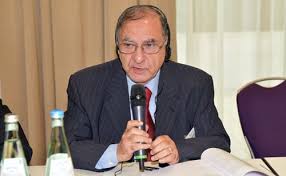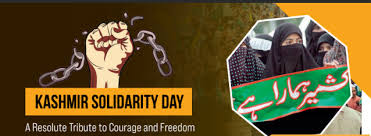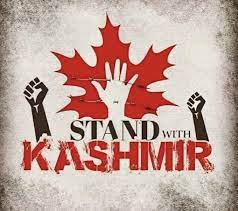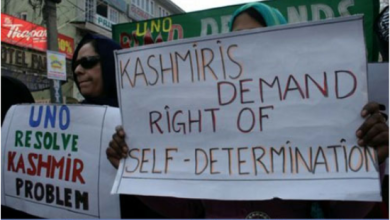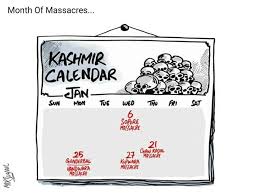 The deceitful occupation of Kashmir by imperialist India is replete with massacres, deception, intrigues, and political fraud. Since 27 October 1947, India has conspired to annihilate Kashmir and snatch their land and resources. The mass massacre in the first month of November 1947 in which over three hundred thousand were butchered by the Dogra army, Indian forces, and Hindu gangs is clear proof that India is hell-bent on wiping out Muslims and reviving Hindu culture in Kashmir. During this biggest human tragedy, thousands of Muslims were forced to migrate to Pakistan. This massacre was carried out to change the demography of Jammu and snatch land of Muslims. Since then Indian forces carried out many massacres in Kashmir and these massacres are part of ethnic cleansing campaign of Kashmiri Muslims.
The deceitful occupation of Kashmir by imperialist India is replete with massacres, deception, intrigues, and political fraud. Since 27 October 1947, India has conspired to annihilate Kashmir and snatch their land and resources. The mass massacre in the first month of November 1947 in which over three hundred thousand were butchered by the Dogra army, Indian forces, and Hindu gangs is clear proof that India is hell-bent on wiping out Muslims and reviving Hindu culture in Kashmir. During this biggest human tragedy, thousands of Muslims were forced to migrate to Pakistan. This massacre was carried out to change the demography of Jammu and snatch land of Muslims. Since then Indian forces carried out many massacres in Kashmir and these massacres are part of ethnic cleansing campaign of Kashmiri Muslims.
United India during its struggle for freedom against the British witnessed only one Jalianwala Bagh massacre but Kashmiris have witnessed dozens of such massacres carried out by Indian forces from 1990.
Month of January is not only the advent of the present phase of the freedom movement in Kashmir but it will also be remembered as the month of massacres in history.
It was in this month in 1990 when the freedom movement was at its peak and millions of Kashmiris took to the streets for the genuine demand of freedom from Indian slavery. The indomitable passion of freedom-loving people unnerved India and it imposed governor rule on 19 January 1990 and appointed RSS goon Jagmohan Malotra who is also known as butcher of Kashmiris as governor of the state. On this date local police on the streets of Srinagar were replaced by India’s brutal Central Reserve Police Force (CRPF). Besides this millions of trigger-happy troops were rushed to Kashmir and this disputed region was converted into the most militarized area of the world. These unbridled forces were given sweeping powers and licence to kill Kashmiris under the armed forces special powers act and other draconian laws. These all preparations were made to carry out a systematic genocide of Kashmiri Muslims. Kashmiri Pandits were also convinced to migrate to Jammu by the governor administration so that Indian forces get free hand to kill Kashmiris on a large scale.
On January 20, 1990, Indian army troops barged into several homes late at night in Srinagar’s Chota Bazaar neighborhood. During the raid, several were beaten, arrested and many women were raped by savage forces. In retaliation, the entire locality marched and held protests against the incident. The locals planned a larger rally for the next morning, which resulted in the Gawkadal Massacre. Indian forces who were fully prepared to carry out the massacre fired indiscriminately on peaceful protesters near Gawkadal Bridge and killed at least 50 civilians and injured over hundred of them.
This massacre was the first mass killing in Kashmir of its kind after the 1947 massacre and this day served as a catalyst to India’s systemic massacres and war crimes in the preceding years. 21st January is the day that changed the course of our 5000 year old history. This is the day when Kashmiris started a peaceful revolution for freedom and bared Indian bullets on their chests but refused to budge before tyranny and illegal occupation.
The Gaw Kadal massacre marked the beginning of a series of massacres in Kashmir.
On January 22, 1990, protests again broke out in Alamgari Bazar neighborhood in which 10 people were killed and many were injured by the CRPF.
On January 25, 1990, Indian forces killed 21 protesters and injured dozens in Handwara on the day before India’s Republic Day. The sea of people who gathered to protest against the military crackdown was peaceful. I am an eyewitness of this great tragedy. Thousands of people voluntarily thronged the streets and chanted pro-freedom slogans. Indian brute forces deployed to kill Kashmiris sprayed bullets on peaceful people which resulted in to the martyrdom of 21 innocent Kashmiris and dozens were injured.
On January 19, 1991, one year later the marketplace of Magarmal Bagh in Srinagar witnessed a brutal military assault by Indian forces. Sixteen people were killed, including Muhammad Ameen Qazi and Bilal Ahmad Qazi while working inside their bicycle shop.
On January 6, 1993 Indian army martyred 57 people in the Sopore market. Some of them were burnt alive after Indian forces set fire to shops and other establishments, destroying 400 businesses and 75 homes. Time Magazine called this massacre and destruction as mayhem. 57 innocent civilians were killed, and the main business area of the town was set ablaze and looted by the Indian BSF troops on that fateful day when they went on a rampage after a rifle was allegedly snatched from a BSF soldier by an unknown individual. Shortly after the incident, Indian BSF personnel from the 94th Battalion butchered 57 civilians. Witnesses of the gruesome massacre recounted that the marauding troops dragged a bus driver out of the vehicle and pumped bullets into the bus passengers, killing 20 of them on the spot. Indian savages snatched a 6-month old child and threw him into the fire and killed the mother with bullets. After killing the passengers, the troops started spraying gunpowder, petrol, and kerosene on the surrounding buildings and then torched them. Among the 57 dead civilians, 48 died due to gunfire, and nine were burnt alive. More than 400 commercial establishments and 75 residential houses were set ablaze in five localities of Sopore namely Arampora, Muslimpeer, Kralteng, Shallapora, Shahabad, and Bobimir Sahab. Among the burnt buildings and shops were landmark structures like the Women’s Degree College. The wounds of this sad and painful tragedy are still fresh in the hearts and minds of the Kashmiri people.
The brutality continued, with massacres in Kupwara on January 27, 1994, where at least 27 people were killed by Indian troops, and in Wandhama on January 25, 1998, where 28 Kashmiri Hindus were murdered by Indian agents, in an attempt to create communal divisions and malign the freedom movement.
These tragedies were not isolated events but part of a broader strategy to terrorize the Kashmiri population and suppress their legitimate demand for freedom. The massacres in places like Sailan Poonch, Zakura, Batamaloo, Magarmal Bagh, Baderwah, Marmat Doda, Bijebihara, Hazratbal, Gojwara, Mashali Mohalla, Khanyaar, Dalgate and many others, serve as grim reminders of India’s genocidal campaign against Kashmiri Muslims. Despite the extreme oppression, the Kashmiri people have remained resolute in their struggle for self-determination.
The courage and resilience of Kashmiris in the face of such brutality is a testament to their unwavering commitment to their cause. The sacrifices of the martyrs are etched in the collective memory of the people, and their spirit continues to inspire the ongoing struggle for freedom. The brutal tactics employed by India have failed to crush the spirit of the Kashmiri people, and the march toward freedom grows stronger with each passing day.
Today, Kashmiris stand united in their pledge to honor the sacrifices of the martyrs, and despite all the hardships and adversity, the mission of these fallen heroes will ultimately reach its desired goal: a free and just Kashmir.
Note: The writer is Insaf Party J&K vice chairman and APHC-AJK chapter leader





